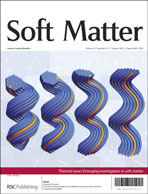Physical, chemical and hybrid tilapia fish gelatin hydrogels were investigated by small-angle neutron scattering (SANS), molecular dynamic simulations and their biological effect in cell cultures studied; results from the different experimental techniques were then correlated and linked to the rheological properties of the gels (F. Bode et al., Biomacromolecules, 2011, 12, 3741–3752). Hydrogels were obtained by cross-linking with the microbial enzyme transglutaminase (mTGase) under two conditions: above and below gelatin physical gelation temperature (ca. 23 °C). Hydrogels cross-linked at 37 °C, from the sol-state, are referred to as ‘chemical’ gels (C); hydrogels cross-linked at 21 °C, thus with concurrent physical gelation, are referred to as ‘physical-co-chemical’ gels (PC). The SANS data were appropriately described by a combination of a Lorentzian and a power law model. For physical gels, the correlation length (ξ) obtained from the fits decreased linearly with gelatin concentration, from 42 to 26 Å for 3.5 to 10% w/w gelatin, respectively. Independently of gelation temperature, all physical gels at a given concentration showed a similar correlation length ξ (26 ± 2 Å), with no significant difference with the sol-state (23 ± 2 Å). In both C and PC gels, ξ increased with mTGase concentration over the range studied: 40 to 167 Å for 10 and 40 U mTGase per g gelatin in C gels (after 120 min cross-linking) and 40 to 82 Å for 10 and 40 U mTGase per g gelatin for PC gels. ξ reached a plateau at the highest mTGase concentration studied for both types of gels. In addition, kinetic studies on C gels revealed that ξ increased linearly with time in the first two hours and grew faster with increasing mTGase concentration. ξ values in the PC gels were smaller than in the corresponding C gels. Cell proliferation studies showed that the gels were compatible with cell growth and indicated no statistically relevant dependence on mTGase concentration for C gels. For PC gels, cell proliferation decreased with increases in mTGase concentration, by approximately 80% from 10 to 40 U mTGase per g gelatin. With the exception of the highest mTGase concentration studied, PC gels overall showed a slightly (but statistically significant) higher cell proliferation than the corresponding chemical gels.


 Please wait while we load your content...
Please wait while we load your content...